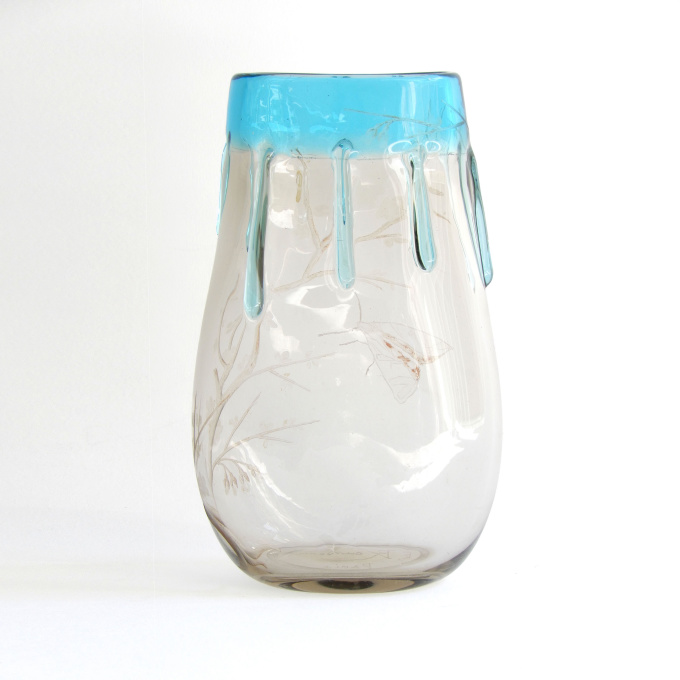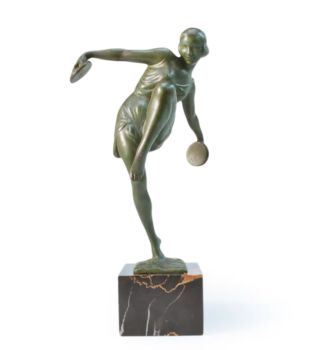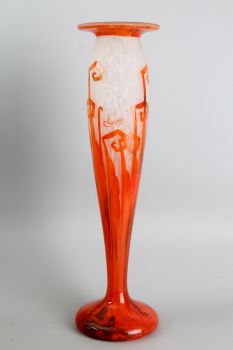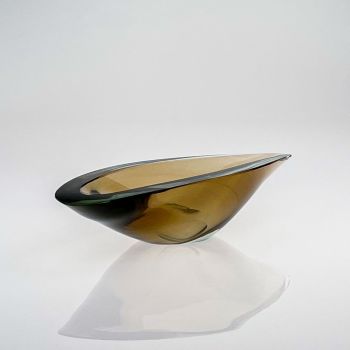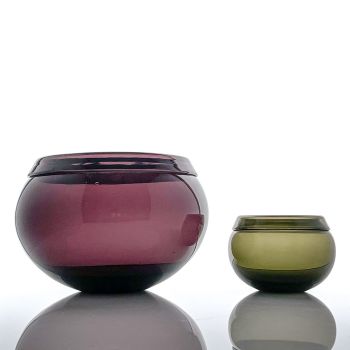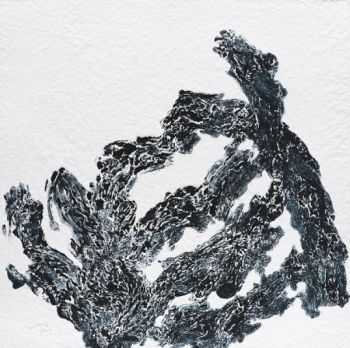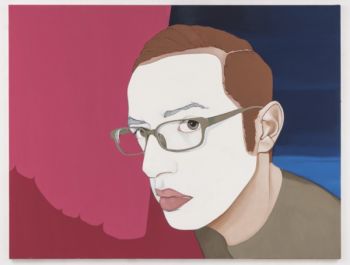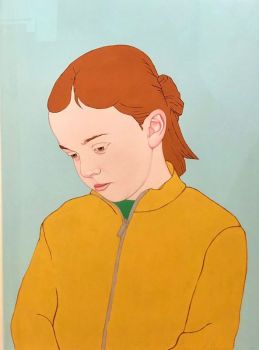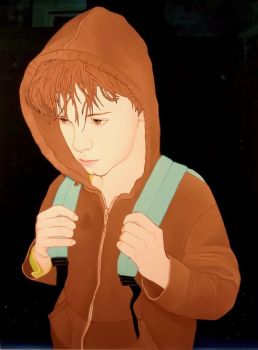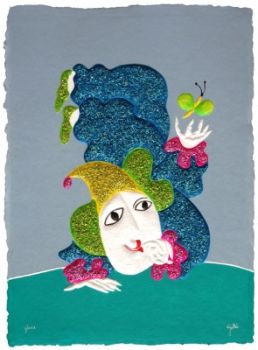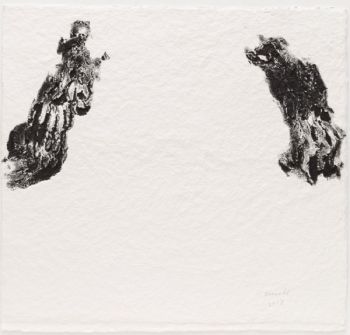Oval vase with a blossom branch 1875 - 1880
François Eugène Rousseau
AfdrukkenGegraveerd
16 cm
ConditionNear mint
Prijs op aanvraag
Dille Art
- Over kunstwerkRare vase by the French designer and creator François Eugène Rousseau (Paris, 1827-1891).
The vase has a very refined decoration inspired by Japanese art, a blossom branch of the quince with a butterfly.
The branch itself is cut in intaglio, the blossom and the butterfly are engraved and partly coloured.
The vase is oval in shape and made of smoky clear glass and double-layered (cased), at the top edge an application of blue glass has been warmly applied to the vase, giving the edge a dripping effect.
The quality of the vase is particularly high. From the middle of the 19th century, Rousseau was very much inspired by Japanese art, which, by opening Japan to foreigners, was just making its appearance in France.
The vase is signed on the bottom with "E. Rousseau Paris".
Biography:
François Eugène Rousseau (Paris, 1827-1891), his father owned a porcelain and ceramics shop on Rue Coqulliere in Paris. Rousseau went to work in his father's shop and also worked at the Manufacture de Sèvres, where he collaborated with several artists. In 1850 he took over the business from his father and also remained associated with the Manufacture de Sèvres. He was very interested in the introduction of Japanese art after the opening of Japan to foreign countries. He immersed himself in it more and decided to design a Japanese tableware with decorations by the painter/etcher Felix Bracquemond (1833-1914). The tableware was also exhibited at the Paris World's Fair of 1867, where it was a great success.
At the same time, he also set up a studio where he experimented with glass and glass decoration. Technically he was completely incompetent and he let his glass made by the brothers Adrien and Léon Appert in Clichy.
Rousseau has many ideas for special designs and decorations. The brothers like to carry it out, Rousseau takes care of the decorations himself, although he does have an assistant Eugène Michel who mainly does the engravings and intaglios.
Rousseau was inventive and original in his designs. His designs were often based on his interest in nature and Japan. Sometimes the shapes of his vases were very austere but applications were applied to them, sometimes his vases were completely free of shape and asymmetrical. He was one of the first French artists to experiment with cased, double-layered glass. He also made crackled glass which he filled in various colours and covered with clear, often coloured glass, creating special effects. Sometimes his glass seemed to be made of gemstone. But he also made double-layered smoky or clear glass vases with an engraved decor or with deeply carved decorations (intaglio technique) that were sometimes (partly) coloured or enamelled, often decorated with applications such as the vase above with a blue dripping effect, ears and/or masks in relief.
His vases were actually only made for special exhibitions, so in 1869 he sold two painted vases to the Albert & Victoria Museum. He also received many positive reactions to the Exposition de l'Union Centrale des Beaux-Arts appliqués à l'Industrie in 1874.
During this period, Ernest-Baptiste Léveillé also became his assistant and the glass cutter Alphonse-Georges Reyen also came to work for him. In 1885 he sold his business to Ernest Baptiste Léveillé, who continued to make the designs of his teacher and friend until 1890. The vases are signed from 1885-1890 with "E. Léveillé and E. Rousseau. After that Léveillé increasingly goes his own way.
François Eugène Rousseau died in 1891. Together with Emile Gallé, he is seen as the forerunner of modern glass art of this time.
Rousseau's vases are very rare and were only produced in small quantities for the major exhibitions, especially those in Paris. They were often purchased by the various museums that bought them for their permanent collections.
Literature:
- Philippe Olland; 'Dictionnaire des Maîtres Verriers de l'Art Nouveau á l'Art Déco Marques & signatures, p. 269-272, Éditions Faton 2016.
- Victor Arwas, 'Glass, Art Nouveau to Art Deco', p. 267-269, Academy Editions London, 1987.
Condition:
Good, the vase is in mint condition, no chips or polishing what so ever, just some colours of the coloured patina in the engraving are faded or washed away because of age and cleaning. - Over kunstenaar
François Eugène Rousseau (Parijs, 1827-1891), zijn vader had een porselein- en keramiekwinkel aan de Rue Coqulliere in Parijs. Rousseau ging werken in de winkel van zijn vader en werkte ook bij de Manufacture de Sèvres, waar hij samenwerkte met verschillende kunstenaars. In 1850 nam hij de zaak over van zijn vader en bleef ook verbonden aan de Manufacture de Sèvres.
Hij was erg geïnteresseerd in de introductie van Japanse kunst na de openstelling van Japan voor het buitenland. Hij verdiepte zich er meer in en besloot een Japans servies te ontwerpen met decoraties van de schilder/etser Felix Bracquemond (1833-1914). Het servies werd ook tentoongesteld op de Parijse Wereldtentoonstelling van 1867, waar het een groot succes was.
Tegelijkertijd richtte hij ook een atelier op waar hij experimenteerde met glas en glasdecoratie. Technisch was hij totaal onbekwaam en hij liet zijn glas maken door de broers Adrien en Léon Appert in Clichy.
Rousseau heeft veel ideeën voor bijzondere ontwerpen en decoraties. De broers voeren het graag uit, Rousseau zorgt zelf voor de versieringen, al heeft hij wel een assistent Eugène Michel die vooral de gravures en intaglio's maakt.
Rousseau was inventief en origineel in zijn ontwerpen. Zijn ontwerpen waren vaak gebaseerd op zijn interesse in de natuur en Japan. Soms waren de vormen van zijn vazen zeer sober maar werden er applicaties op aangebracht, soms waren zijn vazen geheel vrij van vorm en asymmetrisch. Hij was een van de eerste Franse kunstenaars die experimenteerde met dubbel gelaagd glas.
Ook maakte hij gecraqueleerd glas dat hij in verschillende kleuren vulde en bedekte met helder, vaak gekleurd glas, waardoor speciale effecten ontstonden. Soms leek zijn glas van edelsteen te zijn gemaakt. Maar hij maakte ook dubbellaagse rook- of helderglazen vazen met een gegraveerd decor of met diep uitgesneden versieringen (diepdruktechniek) die soms (deels) gekleurd of geëmailleerd waren, vaak versierd met applicaties zoals de vaas erboven met een blauw druipeffect, oren en/of maskers in reliëf.
Zijn vazen werden eigenlijk alleen voor speciale tentoonstellingen gemaakt, dus verkocht hij in 1869 twee beschilderde vazen aan het Albert & Victoria Museum. Hij kreeg ook veel positieve reacties op de Exposition de l'Union Centrale des Beaux-Arts appliqués à l'Industrie in 1874.
In deze periode werd ook Ernest-Baptiste Léveillé zijn assistent en ook de glassnijder Alphonse-Georges Reyen kwam voor hem werken. In 1885 verkocht hij zijn bedrijf aan Ernest Baptiste Léveillé, die tot 1890 de ontwerpen van zijn leermeester en vriend bleef maken. De vazen zijn van 1885-1890 gesigneerd met "E. Léveillé en E. Rousseau. Daarna gaat Léveillé steeds meer zijn eigen manier.
François Eugène Rousseau stierf in 1891. Samen met Emile Gallé wordt hij gezien als de voorloper van de moderne glaskunst van deze tijd.
De vazen van Rousseau zijn zeer zeldzaam en werden slechts in kleine oplagen geproduceerd voor de grote tentoonstellingen, vooral die in Parijs. Ze werden vaak aangekocht door de verschillende musea die ze kochten voor hun vaste collecties.
Bent u geïnteresseerd om dit kunstwerk te kopen?
Artwork details
Related artworks
- 1 - 4 / 24
Frères Daum
Daum Nancy – “Paysage Soleil Couchant” vase with two applied handles1900 - 1910
Prijs op aanvraagAntiques Emporium
Onbekende Kunstenaar
François-Théodore Legras – Tall “Fleurs de Pommier” apple blossoms vase1900 - 1909
Prijs op aanvraagAntiques Emporium
Johann Loetz (Lötz) Witwe Klostermühle
Johann Loetz Witwe – Ausfuehrung 146 Titania vase – 19121910 - 1919
Prijs op aanvraagAntiques Emporium
Demetre Chiparus
Demetre H. Chiparus – Bronze Art Deco statue “Rapture” – Édition Etling, Paris1920 - 1929
Prijs op aanvraagAntiques Emporium
1 - 4 / 24Willem van Konijnenburg
Landschap in Limburg, het zuiden van Nederland1868 - 1943
Prijs op aanvraagKunsthandel Pygmalion
1 - 4 / 24- 1 - 4 / 24
- 1 - 4 / 12

